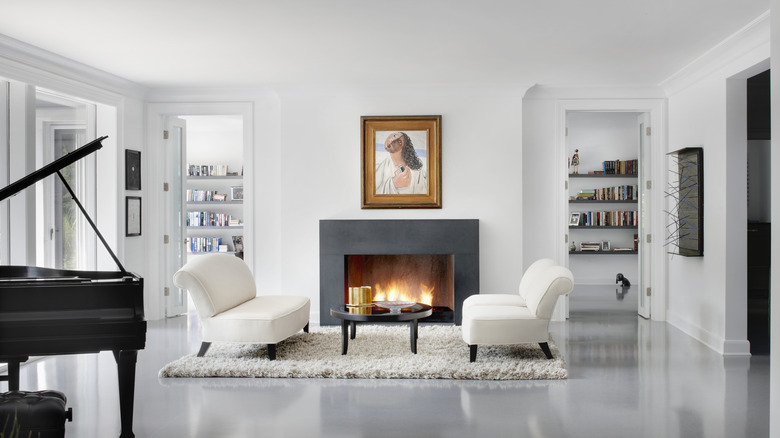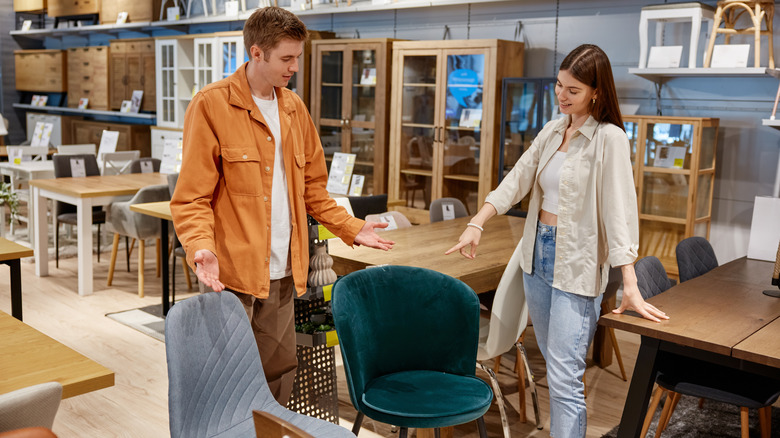How To De-Modernize Your Home And Why You Would Want To
Move over, sleek furniture and sad neutrals. There's a nostalgic design trend floating through our feeds that's taking us back to our roots. Remember your grandma's patterned sofa, ornate chest of drawers, and her collection of quirky décor? Well, dear reader, it turns out that our forebears knew a thing or two about adding personality into their spaces. And now we're seeing a rise of making vintage trends work in modern places — aka de-modernization.
Speaking exclusively to House Digest, design historian and décor expert Sarah Bilotta takes us through how to de-modernize your home — and why you would want to. Bilotta best describes de-modernizing as simply "replacing modern and contemporary décor with classical and traditional décor." This could mean trading geometric furnishings for ornate, exuberant, and embellished ones (e.g. choosing a mirror with a carved giltwood frame instead of a basic border). Or, one of Bilotta's favorite options for de-modernizing: adding some rich, velvety curtains (perhaps textured brocade) to bare windows. "Think about replacing mid-century modern with Regency, art deco with Victorian," she continues.
So why on earth would you go back to old decorating styles when your home is modern and up-to-date? For Bilotta, that alone is enough reason to sprinkle in some old-fashioned charm. "Today, we are caught up in the reality of much of our world being digital and driven by technological change," she explains. "By de-modernizing our homes, we can find some solace away from technology, basking in the appreciation of simpler, more analog pleasures." Traditional décor provides a way to feel simultaneously comforted and sheltered by the familiarity of the past, giving the space a more lived-in and authentic feel.
Tips to de-modernize your home
Drawing inspiration from the video above, blogger @lutzgohome shows us there are many little yet impactful ways to de-modernize a room. For instance, she added faux molding, installed a classic ceiling medallion, embraced a moody palette, and put together a vintage-style gallery wall. This brings us to Sarah Bilotta's top tip: adding embellishment wherever something can be embellished. "Gilding, carving, patterns, and texture are all hallmarks of traditional design movements," she notes in her exclusive interview with House Digest. Even something as simple as spicing up your light switch covers or door knobs with an intricate plate would make a difference.
Bilotta also encourages readers to look for furniture at thrift stores and antique shops. "Much of the Victorian-inspired furniture of the 1990s is now landing on curbs and in trash bins," she shares. "Rescue it, restore it, and apply it to your de-modernized design." And if you need even more inspiration on how to incorporate these past trends into your home, you can always turn to Pinterest. Just search "Georgian design" to encounter a world of striking classical décor.
The don'ts of de-modernizing a home
Remember: this trend is all about creating an environment that comforts you and serves as a refuge from the modern world. That said, there are a few rules of thumb you can follow to guide you on the path to traditional décor. Not holding back on color, pattern, and texture is one of them. "De-modernizing is an opportunity to play with design motifs you may have otherwise avoided," Sarah Bilotta revealed while speaking exclusively to House Digest. But instead of choosing ultra-modern colors like day-glo neons or drenched, bright white, opt for rich, warm tones. Deep browns, reds, and greens come to mind in this case.
Adding to that, the expert says to avoid buying all-new furniture. Lots of fabulous finds are waiting for you at antique and thrift stores — though don't feel pressured to replace everything you own to update your interior. Start with a piece you really love (like a wooden coffee table), then add smaller touches to enhance the traditional vibe. Last but not least, don't let your walls go bare. Art, wallpaper, sconce lighting, and wall décor inspired by classical European design are all great ways to adorn a space with a touch of history.

